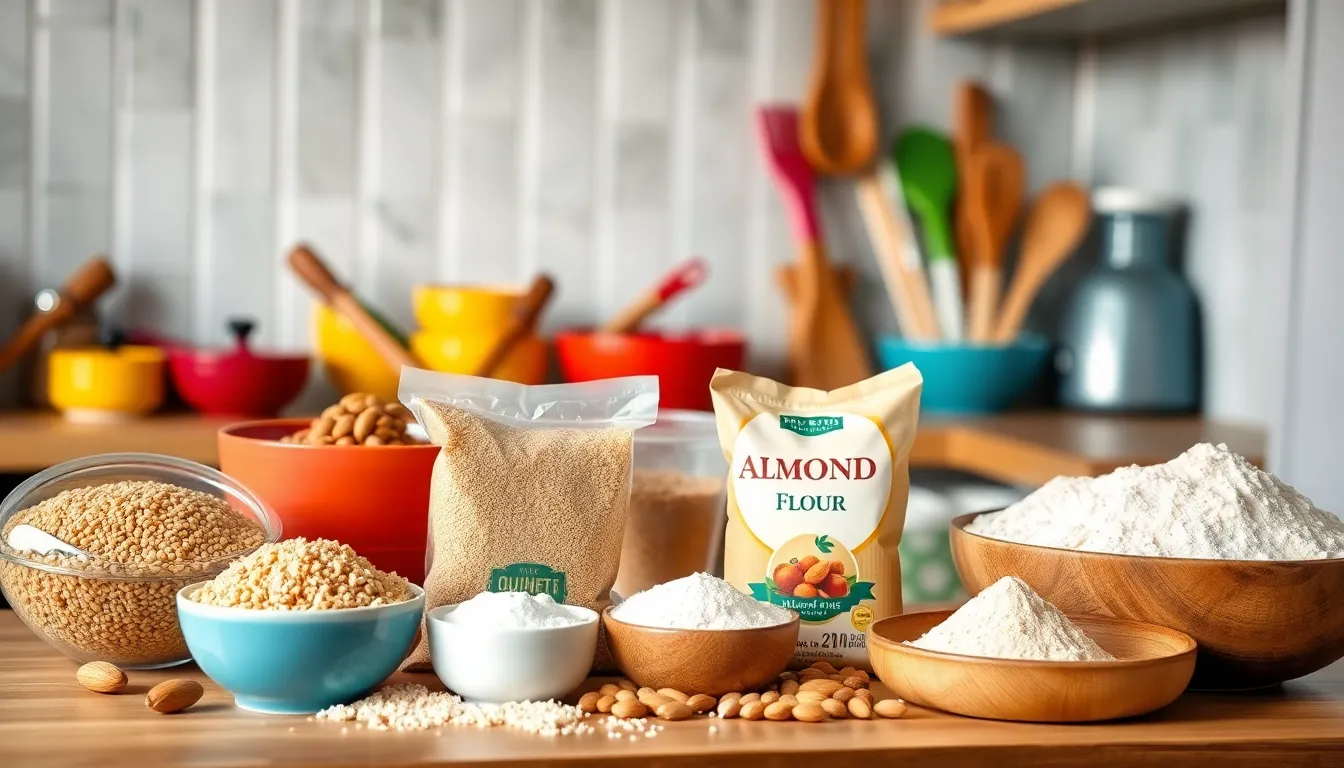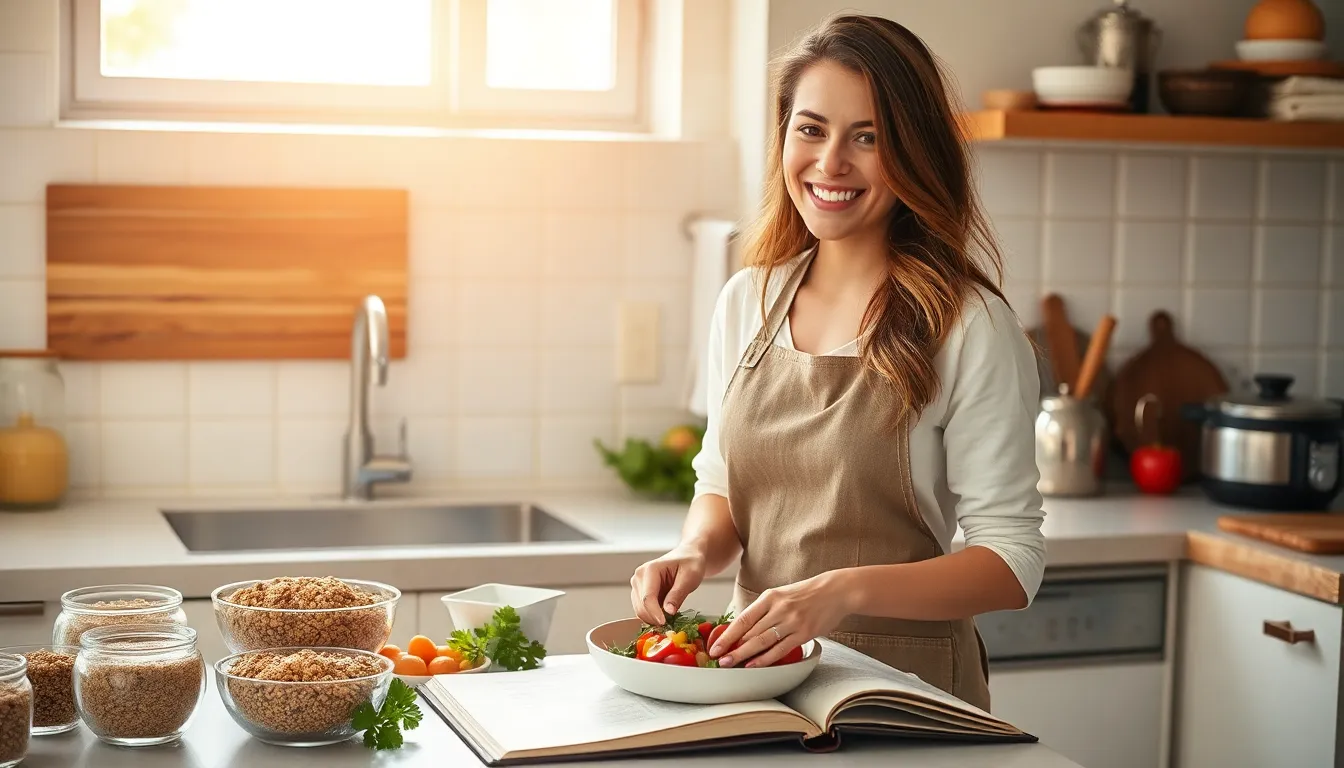Gluten-free cooking isn’t just for those with allergies; it’s a culinary adventure waiting to happen! Imagine whipping up dishes that are not only healthy but also bursting with flavor. Whether it’s a savory pasta that dances on your taste buds or a decadent dessert that leaves you craving more, gluten-free recipes can be surprisingly delightful.
Table of Contents
ToggleBenefits Of Gluten-Free Cooking
Gluten-free cooking offers various advantages that extend beyond accommodating dietary restrictions. Exploring these benefits can enhance both health and environmental sustainability.
Health Benefits
Health gains from gluten-free cooking include better digestion and reduced inflammation. Individuals with celiac disease or gluten sensitivity experience symptoms like bloating and fatigue; eliminating gluten alleviates these issues. Research suggests that many people report increased energy levels when adopting a gluten-free diet. Additionally, choosing whole foods like fruits, vegetables, lean proteins, and gluten-free grains, such as quinoa and brown rice, often results in improved nutrient intake. Enhanced gut health also occurs due to fiber-rich gluten-free options, promoting a balanced microbiome.
Environmental Impact
Gluten-free cooking promotes environmental sustainability through mindful ingredient choices. Many gluten-free foods, particularly fruits and vegetables, require fewer resources compared to wheat production. Reducing reliance on large-scale agriculture benefits ecosystems by decreasing pesticide use and land degradation. Choosing local, organic gluten-free products further minimizes carbon footprints. Many gluten-free grains, like millet and sorghum, often have lower environmental impacts, making them preferable alternatives. Opting for these ingredients can support more sustainable farming practices and encourage biodiversity.
Essential Ingredients For Gluten-Free Cooking

Essential ingredients enhance the flavors and textures in gluten-free cooking. A well-stocked pantry ensures successful meal preparation.
Gluten-Free Grains
Gluten-free grains include quinoa, brown rice, and millet. Quinoa offers a complete protein profile, making it ideal for salads and side dishes. Brown rice serves as a versatile base for stir-fries and grain bowls. Millet provides a mild flavor, perfect for porridge and baked goods. Each grain provides unique textures and nutrients, allowing for diverse meal options. Ensuring a mix of different grains maintains balanced nutrition and flavor variety.
Substitutes For Common Gluten Ingredients
Substitutes for common gluten ingredients facilitate seamless cooking. Almond flour and coconut flour serve as alternatives to wheat flour in various recipes. Almond flour works well in baked goods, providing moisture and a nutty flavor. Coconut flour requires additional liquids but is excellent for pancakes and muffins. Cornstarch and arrowroot powder replace wheat starch in gravies and sauces, thickening without gluten. Uses of these substitutes help create delicious meals while meeting dietary needs. Experimenting with different combinations will lead to preferred textures and flavors.
Tips For Successful Gluten-Free Cooking
Successful gluten-free cooking requires careful attention to detail. Following some essential practices ensures delicious and safe meals for everyone.
Avoiding Cross-Contamination
Cross-contamination poses a significant risk in gluten-free cooking. Keeping gluten-containing foods separate from gluten-free options prevents unintended exposure. Utilize dedicated kitchen tools like cutting boards and utensils. Cleaning surfaces thoroughly before preparing gluten-free meals eliminates residue. Store gluten-free products in clearly labeled containers to avoid mix-ups. Lastly, educate household members about gluten sensitivity to maintain a safe cooking environment.
Measuring Techniques
Accurate measurements play a vital role in gluten-free baking. Using a kitchen scale delivers precise results, enhancing recipe success. Scooping ingredients directly from containers can lead to inaccuracies; instead, spoon flour or grains into measuring cups. Level off with a straight edge for precise portions. When using alternative flours, be aware that many require different hydration levels, which may involve adjustments in liquid ingredients. Adapting measuring techniques elevates the quality of gluten-free dishes, making them just as satisfying as traditional recipes.
Popular Gluten-Free Recipes
Explore a range of delicious gluten-free recipes that satisfy diverse tastes and preferences. From hearty breakfasts to flavorful dinners, these dishes promise to delight.
Breakfast Ideas
Starting the day with gluten-free options doesn’t mean sacrificing taste. Quinoa breakfast bowls provide a nutritious base topped with fruits and nuts. Smoothie bowls packed with spinach, banana, and almond milk deliver vibrant flavors and essential nutrients. Gluten-free pancakes made with almond flour offer a delightful treat that pairs well with maple syrup. Chia seed puddings, rich in omega-3 fatty acids, can be customized with various toppings for added texture and flavor. Breakfast muffins, crafted with coconut flour and berries, make for convenient on-the-go meals.
Dinner Options
Dinner can be equally exciting with gluten-free recipes. Zucchini noodles tossed in a fresh pesto sauce create a light yet satisfying meal. Cauliflower rice stir-fried with vegetables and proteins presents a versatile dish that suits various palates. Grilled chicken marinated in gluten-free soy sauce enhances flavor while ensuring dietary needs are met. Stuffed bell peppers, filled with quinoa, black beans, and spices, offer a hearty and colorful option. Baked salmon seasoned with lemon and herbs brings healthy fats and vibrant taste to the dinner table.
Gluten-free cooking opens up a world of culinary possibilities that extend beyond dietary restrictions. With a focus on health and sustainability it encourages creativity in the kitchen while promoting nutritious ingredients. By exploring various gluten-free grains and substitutes home cooks can craft meals that are both satisfying and delicious.
Embracing gluten-free cooking not only supports individual health but also contributes to a more sustainable food system. By implementing best practices and experimenting with diverse recipes anyone can enjoy flavorful dishes that cater to gluten sensitivities. With the right tools and knowledge anyone can make gluten-free cooking an enjoyable part of their culinary repertoire.





